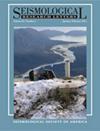Choosing Appropriate Regularization Parameters by Splitting Data into Training and Validation Sets—Application in Global Surface-Wave Tomography
IF 2.6
3区 地球科学
Q2 GEOCHEMISTRY & GEOPHYSICS
引用次数: 0
Abstract
Many linear(ized) geophysical inverse problems cannot be solved without regularization. Finding the regularization parameter that best balances the model complexity and data misfit is often a key step in the inversion problem. Traditionally, this is done by first plotting the measure of model complexity versus data misfit for different values of regularization parameter, which manifests as an L-shaped curve, and then choosing the regularization parameter corresponding to the corner point on the L-curve. For this approach, the difference in units between model complexity and data misfit must be considered, otherwise the result will be strongly affected by the scaling between these two quantities. Inspired by the machine learning literature, we here propose an extension to the traditional L-curve method. We first split the raw dataset into training and validation sets, obtain a solution by performing inversion on the training set only, and calculate data misfits on the validation set. We demonstrate the efficacy of this approach with a toy example and with two synthetic datasets. In realistic global surface-wave tomography studies where sampling of the Earth is nonuniform, we devise a procedure to generate a validation dataset with sampling as uniform as possible. We then show that the regularization parameter can be determined using this validation set, and this determination is apparently robust to the ratio of data split between training and validation sets. For both synthetic tests and realistic inversions, we find that our procedure can produce a minimal point that can be easily identified on the misfit curves calculated on the validation sets, and avoids the nuances encountered in the traditional L-curve analysis.通过将数据分成训练集和验证集来选择合适的正则化参数--在全局表面波断层扫描中的应用
许多线性(化)地球物理反演问题都离不开正则化。找到最能平衡模型复杂性和数据误拟合的正则化参数往往是反演问题的关键步骤。传统的做法是,首先绘制不同正则化参数值下的模型复杂度与数据不拟合度的对比图(表现为 L 型曲线),然后选择与 L 型曲线上的角点相对应的正则化参数。对于这种方法,必须考虑模型复杂度和数据误拟合之间的单位差异,否则结果会受到这两个量之间的比例关系的强烈影响。受机器学习文献的启发,我们在此提出了对传统 L 曲线方法的扩展。我们首先将原始数据集拆分为训练集和验证集,仅在训练集上执行反演获得解决方案,然后计算验证集上的数据误差。我们用一个玩具实例和两个合成数据集证明了这种方法的有效性。在现实的全球地表波层析成像研究中,地球的采样是不均匀的,我们设计了一个程序来生成采样尽可能均匀的验证数据集。然后,我们证明可以利用该验证集确定正则化参数,而且该确定方法对训练集和验证集之间的数据分割比例具有明显的稳健性。对于合成测试和实际反演,我们发现我们的程序可以产生一个最小点,这个最小点可以很容易地在验证集计算的误拟合曲线上识别出来,并避免了传统 L 曲线分析中遇到的细微差别。
本文章由计算机程序翻译,如有差异,请以英文原文为准。
求助全文
约1分钟内获得全文
求助全文
来源期刊

Seismological Research Letters
地学-地球化学与地球物理
CiteScore
6.60
自引率
12.10%
发文量
239
审稿时长
3 months
期刊介绍:
Information not localized
 求助内容:
求助内容: 应助结果提醒方式:
应助结果提醒方式:


